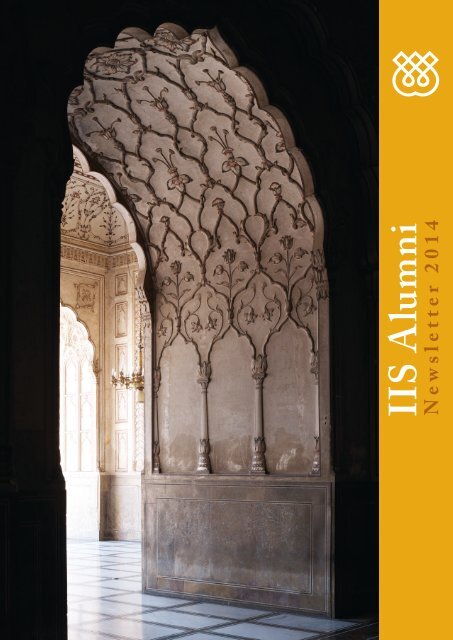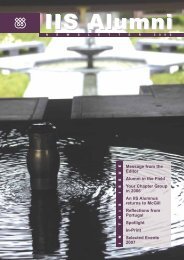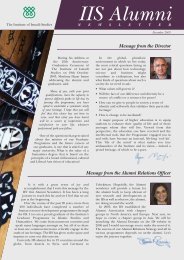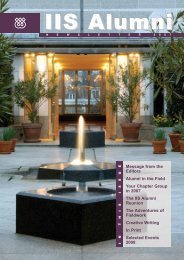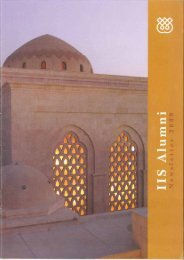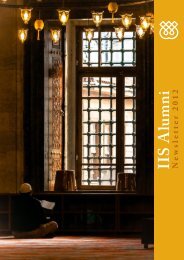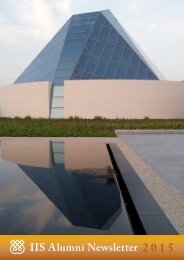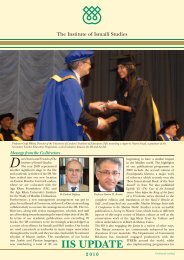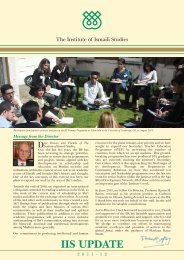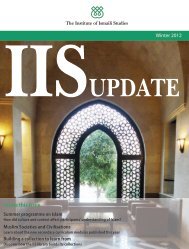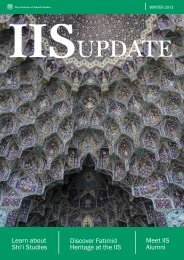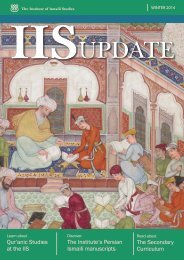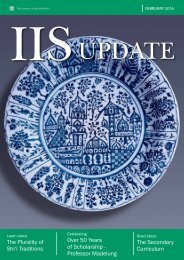IIS Alumni Newsletter 2014
You also want an ePaper? Increase the reach of your titles
YUMPU automatically turns print PDFs into web optimized ePapers that Google loves.
<strong>IIS</strong> <strong>Alumni</strong><br />
<strong>Newsletter</strong> <strong>2014</strong>
Messages<br />
Message from the Co-Director<br />
To all <strong>IIS</strong> alumni,<br />
It gives me great pleasure to<br />
address this message to the<br />
alumni of The Institute of<br />
Ismaili Studies. The year <strong>2014</strong><br />
marked the 20th anniversary of<br />
the launch of the <strong>IIS</strong>’ Graduate<br />
Programme in Islamic Studies<br />
and Humanities (GPISH). Since<br />
its inception in 1994, when we welcomed the first<br />
cohort of 13 students from five countries, 17 cohorts<br />
comprising a total of 197 individuals have graduated<br />
from this programme and are now part of our alumni<br />
body. This year also marks the 10th anniversary of the<br />
establishment of the <strong>IIS</strong> <strong>Alumni</strong> Association, which has<br />
grown steadily and become increasingly vibrant.<br />
Throughout the past two decades, we have continuously<br />
examined ways to improve our progammes. In<br />
September <strong>2014</strong>, we launched a new curriculum for<br />
GPISH, which was developed under the guidance of the<br />
<strong>IIS</strong>’ Academic Steering Committee. Having received<br />
positive feedback from both students and faculty, the<br />
revised curriculum aims to keep the programme aligned<br />
to its original philosophy. In 2015, a similar review of<br />
the Secondary Teacher Education Programme (STEP)<br />
will be undertaken<br />
An important landmark achievement on our path to<br />
academic excellence will be the accreditation of our<br />
graduate programmes. To help us achieve this, I am<br />
happy to announce the establishment of a Quality<br />
Assurance and Enhancement Unit, operating within<br />
the Director’s Office.<br />
We have recently joined an exciting initiative called<br />
the Knowledge Quarter. Led by the British Library,<br />
this initiative brings together 35 academic, cultural,<br />
research, scientific and media organisations involved in<br />
promoting learning in the King’s Cross area of London.<br />
Part of the group’s mission is to foster collaboration<br />
and networking that will drive research, economic<br />
development and entrepreneurship for the benefit of<br />
various knowledge seekers. Our involvement allows the<br />
<strong>IIS</strong> to contribute to discussions between organisations<br />
and create a greater awareness of our own academic<br />
work amongst other prominent educational and<br />
research institutions in London.<br />
I am delighted to report that the planning of<br />
permanent facilities for <strong>IIS</strong> and AKU-ISMC at King’s<br />
Cross is progressing well. In early 2016, we look<br />
forward to moving our students to the new student<br />
accommodation facility at King’s Cross. Plans for the<br />
Academic Building are being finalised and construction<br />
is expected to start in the near future. The <strong>IIS</strong> and<br />
AKU-ISMC libraries were joined in <strong>2014</strong> and we have<br />
begun to share our language faculty across the graduate<br />
programmes run by both institutions. We look forward<br />
to further collaborations with the ISMC.<br />
I would like to express my gratitude for your support of<br />
the <strong>IIS</strong>. I encourage your continued engagement with<br />
us on this exciting journey towards academic excellence<br />
and service to the global Jamat.<br />
Dr. Farhad Daftary<br />
In his message, Dr Farhad Daftary has highlighted the<br />
two milestones of <strong>2014</strong>: the twentieth anniversary<br />
of the launch of GPISH and the tenth anniversary<br />
of the establishment of the <strong>IIS</strong> <strong>Alumni</strong> Association. For<br />
me, personally, it is indeed most pleasing that I have<br />
been the <strong>Alumni</strong> Relations Coordinator for six of those<br />
ten years.<br />
The year <strong>2014</strong> was an exciting year, with chapter group<br />
meetings held in Atlanta, Lahore and Mahdia. While<br />
Mahdia has less than 100,000 inhabitants, Atlanta,<br />
with a population of nearly 500,000, is the ninth largest<br />
metropolitan area in the USA, and Lahore is one of<br />
the most densely populated cities in the world, with<br />
nearly 10 million inhabitants. Although there is a huge<br />
disparity in the population figures, all three locations are<br />
culturally and historically significant. Lahore is referred<br />
to as the cultural heart of Pakistan and has been a<br />
regional capital of various Muslim dynasties in history.<br />
Atlanta is the childhood home of Dr Martin Luther<br />
King, Jr., and has played a vital role in the history of<br />
the Civil Rights Movement.<br />
And Mahdia, although<br />
the smallest in terms of<br />
population, is perhaps<br />
the most significant from<br />
an Ismaili perspective; it<br />
was founded nearly eleven<br />
hundred years ago by<br />
Imam-Caliph ‘Abd Allah<br />
al-Mahdi and became the<br />
first Fatimid capital city.<br />
The alumni body is growing<br />
and is vibrant. However,<br />
for it to remain an exciting and relevant organisation,<br />
your continuing support is not only necessary but vital.<br />
I would like to take this opportunity to welcome new<br />
alumni and wish them the very best as they begin their<br />
careers. Congratulations!<br />
Shellina Karmali, <strong>Alumni</strong> Relations<br />
Coordinator
North American Chapter Group<br />
<strong>Alumni</strong> from across Europe met in<br />
Mahdia, Tunisia, for their annual<br />
meeting on 4-7 May. The meeting<br />
brought together 32 alumni to explore<br />
“Culture, Art and Architecture of the Fatimids<br />
and its reflection in Modern Mahdia.”<br />
Speakers at the meeting included<br />
Professor Moncef Ben Abdeljelil<br />
(University of Sousse), Dr Otared Haidar<br />
(GPISH Class of 1998), Dr Shainool<br />
Jiwa (McGill Class of 1984), Mr Shiraz<br />
Kabani (Head of Community Relations,<br />
<strong>IIS</strong>), Professor Faouzi Mahfoudh<br />
(Manouba University), Mr Alnoor<br />
Merchant (McGill Class of 1987), and<br />
Dr Stephane Pradines (AKU-ISMC).<br />
Asian Chapter Group<br />
<strong>Alumni</strong> from across North America met in<br />
Atlanta, USA, for their annual meeting on<br />
20-22 June. The meeting brought together<br />
over 50 alumni to explore “Women and Gender<br />
in Islam.” Speakers at the meeting included<br />
Professor Rumee Ahmed (Assistant Professor of<br />
Islamic Law, University of British Columbia),<br />
Professor Ayesha Chaudhry (Assistant Professor<br />
of Islamic and Gender Studies, University of<br />
British Columbia), Mr Alim Fakirani (STEP<br />
Class of 2009), Mr Shiraz Kabani (Head<br />
of Community Relations, <strong>IIS</strong>), Ms Shenila<br />
Khoja-Moolji (Teachers College, Columbia<br />
University), Mr Steve Lewitt (Head of HR, <strong>IIS</strong>)<br />
and Mr Adil Mamodaly (STEP Class of 2010).<br />
European Chapter Group<br />
<strong>Alumni</strong> from across Asia and Africa met in<br />
Lahore, Pakistan, for their annual meeting on<br />
14-17 August. The meeting brought together<br />
over 30 alumni to explore “The Role of the Arts<br />
in Social Development.” Speakers at the meeting<br />
included Mr Rafiq Ajani (GPISH Class of<br />
2006), Professor Naazish At-Ullah (Beaconhouse<br />
National University, Lahore), Mr Salman Beg<br />
(CEO, Aga Khan Cultural Services, Pakistan),<br />
Mr Nayyar Ali Dada (Architect), Mr Amin<br />
Gulgee (Artist/Sculptor), Mrs Mooneza Hashmi<br />
(President of the Commonwealth Broadcasting<br />
Association), Mr Shiraz Kabani (Head of<br />
Community Relations, <strong>IIS</strong>), Mr Aziz Kabani<br />
(GPISH Class of 1999), Mr Kamran Lashari<br />
(Director General, Walled City of Lahore<br />
Authority), Ms Farrah Musani (GPISH Class<br />
of 2005), and Professor Arfa Zehra (Forman<br />
Christian College, Lahore).<br />
Chapter Groups - Asia Europe North America
<strong>IIS</strong> PhD Scholarship Recipients<br />
Sultonbek Aksakolov (GPISH 2002)<br />
Sultonbek Aksakolov<br />
received his first degree<br />
in Tajik Philology<br />
from Khorog State<br />
University in Tajikistan<br />
in 1997, following<br />
which he completed<br />
a graduate course in<br />
Islamic Studies and<br />
Humanities at the<br />
<strong>IIS</strong> in 2001. In 2002,<br />
he was awarded an<br />
MPhil in Sociology and Politics of Modern Society<br />
from the University of Cambridge. After working for<br />
several years (2004–2010) as a Research Assistant in the<br />
Institute’s Central Asian Studies Unit (CASU), he was<br />
granted a doctoral scholarship and, in 2013, he earned<br />
a PhD in History from SOAS, University of London.<br />
His PhD thesis, entitled ‘Islam in Soviet Tajikistan: State<br />
Policy and Practice of Religion (1941–1991)’, is based on<br />
the analysis of the Soviet state archives preserved in the<br />
Russian Federation and Tajikistan. In the past, Sultonbek<br />
has worked as a researcher at the Institute of Humanities<br />
in Khorog, Tajikistan, from 1997 to 1999, and in the<br />
Silk Road Studies Program at the Uppsala University,<br />
Sweden, in 2004.<br />
His interest in the modern history of Central Asia, Islam<br />
and the former Soviet Union were fostered through<br />
extensive research in the archives and libraries, as well as<br />
ethnographic field research in Tajikistan and the Russian<br />
Federation. As a researcher with the CASU, he completed<br />
major projects on: (1) religious identity among migrants<br />
in southern Tajikistan; (2) the formation of Ismaili<br />
migrant organisations in the Russian Federation; (3)<br />
Soviet scholarship on Ismailis; and (4) Post-Soviet Russian<br />
and Tajik publications on Islam in Central Asia. He has<br />
presented peer-reviewed papers on these topics at several<br />
international conferences.<br />
In addition to conducting independent research projects,<br />
Sultonbek has gained substantial teaching experience.<br />
From 2006 to 2010, he worked in a collaborative team at<br />
the CASU to design syllabi and to teach: (i) a course on<br />
Islam in Central Asia; (ii) a module on migration in the<br />
Soviet and post-Soviet periods; and (iii) a module on the<br />
Ismailis of Central Asia, all as part of the modern history<br />
course for graduate students at the <strong>IIS</strong>. Between 2012 and<br />
2013, he worked as a Teaching Fellow at the Department<br />
of History, SOAS, University of London.<br />
In February <strong>2014</strong> Sultonbek completed his postdoctoral<br />
fellowship with the Department of Academic Research<br />
and Publications at the <strong>IIS</strong>. He is now finalising his<br />
book for publication, which builds upon his doctoral<br />
dissertation. The book examines the ways in which Soviet<br />
religious policies were implemented among Muslim<br />
communities in Soviet Tajikistan between 1950 and 1985.<br />
During his time at the <strong>IIS</strong>, Sultonbek has also provided<br />
methodology workshops for early career researchers and<br />
postgraduate students from Central Asia and the Russian<br />
Federation; mentored graduate students from the UK<br />
for their field projects in Central Asia; assisted in the<br />
organisation of conferences and seminars. Additionally,<br />
he has translated educational materials for the <strong>IIS</strong> and<br />
publications by the Open Society Institute Assistance<br />
Foundations in Tajikistan. He also helped with annotations<br />
for the memoir of Wladimir Ivanow, Fifty Years in the East<br />
(2015), which was edited by Dr Farhad Daftary.<br />
Zamira Dildorbekova (GPISH 2008)<br />
Zamira received her BA (Hons) in English and German<br />
Language and Linguistics from Khorog State University,<br />
Tajikistan, in 2000. Prior to pursuing further studies, she<br />
taught Academic English as well as modules in Islamic<br />
Studies and the Humanities at the Khorog English<br />
Programme (KEP) in Tajikistan between 1998 and<br />
2005. From 2000 to<br />
2001, she worked<br />
as a Programme<br />
Officer at the Aga<br />
Khan Foundation<br />
(Education), providing<br />
methodology training<br />
to secondary school<br />
teachers in the<br />
Gorno-Badakhshan<br />
region of Tajikistan.<br />
She completed the<br />
Graduate Programme in Islamic Studies and Humanities<br />
(GPISH) at the <strong>IIS</strong> in 2007, and an MPhil (by research)<br />
in Development Studies at the Institute of Development<br />
Studies, University of Sussex, in 2009.<br />
Zamira’s interest in the field of Islamic Studies and the<br />
study of contemporary Muslim societies led her to pursue<br />
a doctoral degree in Islamic Studies at the University of<br />
Exeter in 2009. Her PhD thesis, entitled ‘The Dynamics<br />
of Islam and Modernity in Tajikistan’, examines the<br />
contemporary religious renewal and discourses on<br />
modernity of the Nizari Ismailis in Tajikistan. It covers<br />
the period between 1991 – when the Tajiks gained<br />
independence from the Soviet Union – and 2012. The<br />
work examines the ways in which the Tajik Ismailis<br />
reconnected with their spiritual leader, the Aga Khan<br />
IV, and reintegrated with the transnational Ismaili<br />
community after seventy years of Soviet isolation. The<br />
subject of ‘religious renewal’ among the Ismailis in post-<br />
Soviet Tajikistan remains barely explored, both in post-<br />
Soviet and Western academia; thus Zamira’s research<br />
contributes to the furthering of knowledge in this area.<br />
In addition to pursuing her studies and conducting<br />
research, Zamira has worked as a graduate teaching<br />
assistant for two GPISH modules at the <strong>IIS</strong> (2010–2011)<br />
– ‘Islamic History: Authority, Power and Body Politic’<br />
and ‘Muslims in the Regional Context: South Asia’ – and<br />
again as a teaching assistant in 2012 at the Institute of<br />
Arab and Islamic Studies, the University of Exeter, for<br />
the module ‘History and Society in the Middle East,<br />
610–1980s’. During her time as a PhD student, Zamira<br />
presented papers at several conferences on the subject of
Central Asian Islam and on the theoretical frameworks<br />
used to study it. Since 2012, she has contributed to<br />
teaching the ‘Research Methods’ module for GPISH<br />
and STEP students at the <strong>IIS</strong>. In 2010, she was made an<br />
associate member of the Higher Education Academy in<br />
recognition of her teaching, and she is presently a member<br />
of the Regional Seminar for Excellence in Teaching,<br />
titled ‘Islam: Religious and Social Practices. Universality<br />
and Locality’.<br />
Currently, Zamira works at the <strong>IIS</strong>, in the Department<br />
of Curriculum Studies, where she is responsible for<br />
the development of educational materials – primarily,<br />
teachers’ guides and supporting resources for the<br />
Institute’s Secondary Curriculum. She continues to be<br />
involved in supervising MA research projects, mentoring<br />
lesson planning, and teaching graduate students at the<br />
<strong>IIS</strong>.<br />
Laila Kadiwal (GPISH 2009)<br />
Laila Kadiwal is<br />
originally from a small<br />
settlement in India<br />
called Gadhchiroli.<br />
Armed with a change<br />
of clothes and her<br />
certificates, she left<br />
home to pursue her<br />
dreams, despite her<br />
family’s resistance,<br />
seeking an education<br />
and career. Without<br />
any knowledge of English and very little money, she<br />
could never have anticipated that she would find herself<br />
teaching and researching at a prestigious university in the<br />
UK a decade and a half later.<br />
For Laila, the life-changing opportunity came in 2006,<br />
in the form of the <strong>IIS</strong>’s Graduate Programme in Islamic<br />
Studies and Humanities (GPISH). She completed the<br />
programme with the highest marks in her cohort, and<br />
then went on to obtain a Masters in Educational Studies<br />
from the University of Oxford (with distinction in the<br />
exam); and a Postgraduate Certificate in Education in<br />
Research Methods in <strong>2014</strong>, and a Doctor of Philosophy<br />
degree from the University of Sussex in 2015.<br />
Laila’s PhD thesis, entitled ‘Religious Pluralism in<br />
Ismaili Muslim Religious Education: From Difference<br />
to Diversity’, investigates Ismaili trainee teachers’<br />
attitudes to plurality in the Secondary Teacher Education<br />
Programme (STEP). Laila’s research was conducted over<br />
a span of three years, and involved in-depth interviews,<br />
focus group activities, observations and textual analysis.<br />
Twenty-one trainee teachers from thirteen different<br />
countries participated in the study. Alan Race’s (1983)<br />
typology ‘inclusivism–exclusivism–pluralism’ serves as<br />
a key theoretical lens through which she examines the<br />
trainees’ attitudes to religious others.<br />
Laila has taught research methods and sociology in wellknown<br />
universities in the UK, Sweden and China, and<br />
conducted research in diverse countries such as China,<br />
UAE and Tajikistan. She worked as the South Asian<br />
Student Support Officer at the University of Sussex and<br />
a Research Assistant at the <strong>IIS</strong>. She has published a paper<br />
entitled ‘“Selective Cosmopolitans’: Tutors’ and Students’<br />
Experience of Offshore Higher Education in Dubai”. She<br />
has also presented papers at high profile conferences, such<br />
as the annual conferences of the European Association<br />
for the Study of Religions, the British Sociological<br />
Association, and the British Association for International<br />
and Comparative Education.<br />
In October <strong>2014</strong>, Laila joined the University of Sussex<br />
as a Research Fellow on the Education and Peacebuilding<br />
project. Working in collaboration with her colleagues<br />
at the university, Laila’s research focuses on the role<br />
of teachers in post-conflict societies in South Africa,<br />
Pakistan, and South Sudan. The research aims to inform<br />
the national and global policy dialogue on, and the<br />
understanding of, teachers as agents of peacebuilding<br />
programmes. It also aims to uncover and communicate<br />
new knowledge to policy experts, policy makers, and<br />
civil society organisations at local, national, regional<br />
and international levels on the effects and outcomes of<br />
peacebuilding interventions through education.<br />
Shayesteh Ghofrani (GPISH 2006)<br />
Shayesteh submitted her PhD thesis in October <strong>2014</strong> to<br />
the Institute of Arab and Islamic Studies, the University<br />
of Exeter, under the supervision of Prof. Robert Gleave.<br />
Her thesis, entitled ‘Comparative Analysis of Wilāya in<br />
the Formative Period of Shi’ism and Sufism’, looks at<br />
the development of the concept of wilāya, particularly<br />
between the eighth and the tenth centuries CE. The word<br />
wilāya literally means<br />
to be near to someone<br />
or something, and it<br />
is a term with a range<br />
of meanings in the<br />
political, religious and<br />
legal spheres.<br />
Shayesteh’s inspiration<br />
to conduct this research<br />
came from the wellknown<br />
fourteenthcentury<br />
Muslim historian and author, Ibn Khaldūn (d.<br />
784/1382). Ibn Khaldūn was the first to notice the close<br />
affinity between the Sufi concept of wilāya and the Shi’i<br />
concept of the imām. He looked at the early histories of<br />
both Shi’ism and Sufism, and concluded that Sufism was<br />
virtually saturated with Shi’i ideas. Surprisingly, such a<br />
comparison, broached by a historian in the fourteenth<br />
century, has received only scant attention in academia.<br />
Thus, Shayesteh’s research can be seen as an extension<br />
of Ibn Khaldūn’s project. Her focus is not on the general<br />
practices, as Ibn Khaldūn’s was, but on the conceptual<br />
development of the notion of wilāya. Her research is<br />
therefore a small step towards redressing the balance, in<br />
that it focuses on the sources earlier than the tenth century<br />
to see how the notion of wilāya came about and to uncover<br />
<strong>IIS</strong> PhD Scholarship Recipients
<strong>IIS</strong> PhD Scholarship Recipients<br />
the doctrinal aspects that gave initial shape to the form of<br />
wilāya within Shi’ism and Sufism.<br />
Her findings show that, in the formative period, the<br />
ideas of the Shi’is and the Sufis were remarkably similar<br />
regarding the scope of the concept of wilāya. From the<br />
beginning of the history of the usage of the term, both<br />
groups required an acceptable justification in advocating<br />
wilāya for the imām or the walī (pl. awliyā’), respectively.<br />
The word wilāya is quite unique in the sense that, in<br />
its most basic understanding, it designates a type of<br />
relationship between persons of equal or unequal stature.<br />
Shi’is appropriated the concept of wilāya to express their<br />
understanding of the role of the imām as well as the role<br />
of the Shi’i community with respect to the imām, whereas<br />
Sufis appropriated the same concept to express the role<br />
of the awliyā’ and their spiritual distinctions. Shayesteh’s<br />
research demonstrates that wilāya, within Islamic<br />
discourse, is a fundamental concept that underlies notions<br />
of spiritual identity and community in a variety of Islamic<br />
contexts, which is still evident today.<br />
Shayesteh is a graduate of the GPISH class of 2006.<br />
She is from Iran and obtained her BSc in Engineering<br />
from the Amir Kabir University in Tehran in 2002. She<br />
received her Masters in Continental Philosophy from the<br />
University of Warwick in 2006. Having recently defended<br />
her PhD thesis, Shayesteh now works in the Department<br />
of Academic Research and Publication (DARP) at the <strong>IIS</strong><br />
as a postdoctoral research fellow.<br />
Nourmamadcho Nourmamadchoev<br />
(GPISH 2005)<br />
In 1997 Nourmamadcho Nourmamadchoev was awarded<br />
a BA in Oriental Studies (Arabic and Persian Language<br />
and Literature) from Khorog State University, Tajikistan.<br />
Subsequently, he went<br />
on to teach Arabic<br />
and Persian at his alma<br />
mater, and also started<br />
working as a researcher<br />
at the Institute of<br />
Humanities in the<br />
Khorog branch of<br />
the Tajik Academy of<br />
Sciences. During this<br />
time, his interest in the<br />
study of Islam grew,<br />
particularly the systematic study of Islam and its Ismaili<br />
tariqah in Badakhshan. This interest came to inform his<br />
later research.<br />
In 2001 Nourmamadcho enrolled in the intensive oneyear<br />
Khorog English Programme and, upon successfully<br />
completing this course, he was offered a place in the<br />
Graduate Programme in Islamic Studies and Humanities<br />
at the <strong>IIS</strong>. In the third year of this programme, he joined<br />
the Oriental Studies Department at the University of<br />
Cambridge. There, he received an MPhil in Middle<br />
Eastern and Islamic Studies in 2005, after submitting<br />
his thesis – entitled ‘The Political and Social History<br />
of Badakhshan up to the End of the 11th Century’ –<br />
which was supervised by Prof. Charles Melville. In that<br />
same year, he was awarded an <strong>IIS</strong> Doctoral Scholarship<br />
which enabled him to pursue a PhD at the Department<br />
of History, SOAS, University of London. He successfully<br />
completed this in <strong>2014</strong> – under the supervision of Dr<br />
Heidi A. Walcher and, later, Dr Konrad Hirschler; his<br />
thesis was titled ‘The Ismailis of Badakhshan: History,<br />
Politics and Religion from 1500 to 1750’.<br />
Nourmamadcho currently works as a research and<br />
administrative assistant at the <strong>IIS</strong>’s newly established<br />
Ismaili Special Collections Unit in London. In addition<br />
to his duties there, he is presently preparing to publish<br />
a monograph on Badakhshan, based on his doctoral<br />
dissertation. The forthcoming monograph concentrates<br />
on the history, politics and religion of the Shi’a, including<br />
Ismailis, minority groups in Badakhshan between 1500<br />
and 1750, and examines these aspects within the wider<br />
context of the history of Central Asia and the Persianate<br />
world.<br />
The work is divided into three parts. Part One, ‘The<br />
Geography and People of Badakhshan’, describes the<br />
geography of the region and the ethnic composition of<br />
those dwelling within its borders. Part Two, ‘The Political<br />
History of Badakhshan’, explores the origin and the reign<br />
of the mirs and shahs of Badakhshan; traces the transfer of<br />
political control of the region from the local rulers to the<br />
invading powers, such as the Timurids, the Shaybanids<br />
and later on the Tuqay-Timurids; and charts the rise of<br />
Mir Yaribeg Khan and the establishment of the Yaribeg<br />
Khanid (or Yarid) dynasty that brought relative peace<br />
to the region. Part Three, ‘Ismailism in Badakhshan’,<br />
is devoted to the study of the religious composition of<br />
the region, particularly the spread of Ismaili teaching in<br />
Badakhshan and the Pamir districts.<br />
The history, politics and culture of medieval and<br />
early modern Badakhshan is still largely shrouded<br />
in mystery, being understudied areas in the fields of<br />
Islamic Studies, Central Asian Studies, and the studies<br />
of Persianate societies. The forthcoming monograph is<br />
therefore Nourmamadcho’s attempt to fill this gap in the<br />
scholarship.<br />
Sharaf Oshurbekov (GPISH 2004)<br />
Sharaf Oshurbekov received his undergraduate degree in<br />
history from Khorog<br />
State University,<br />
Tajikistan, in 2000,<br />
and completed the<br />
Graduate Program in<br />
Islamic Studies and<br />
Humanities at the <strong>IIS</strong><br />
in 2004. In 2005, he<br />
was awarded an MA<br />
degree in Near and<br />
Middle Eastern Studies<br />
from the School of<br />
Oriental and African Studies, and in <strong>2014</strong> completed a<br />
PhD in Social Anthropology at York University, Canada.
Sharaf ’s doctoral dissertation examines the ways in which<br />
the Ismaili Muslims in the Badakhshan region of modernday<br />
Tajikistan understand and relate to the sites in their<br />
landscape that they deem ‘sacred’. His dissertation is<br />
based on the ethnographic data that he collected during<br />
his fieldwork in Badakhshan from 2011 to 2012. It also<br />
draws from the data on the various religious practices of<br />
the Ismailis of this region, which was collected by local<br />
researchers and stored in the archives of the Khorog<br />
Research Unit of the <strong>IIS</strong>’ Central Asian Studies Unit.<br />
Through these stories and narratives, sacred sites validate<br />
and confirm the presence of the transcendent in the<br />
lived environment of the people. Sharaf ’s research thus<br />
contributes to the conceptualisation and understanding<br />
of the relationship between human societies and places in<br />
their lived environment.<br />
While studying for his PhD, Sharaf also took part in the<br />
Regional Seminar for Excellence in Teaching project,<br />
‘Anthropological Approaches to Religion and Secularism’,<br />
which ran from 2010 to 2013. In collaboration with forty<br />
other scholars from different countries, he analysed and<br />
discussed the existing literature on the subject of religion<br />
and secularism, identified new avenues for the study of<br />
this issue, and conceptualised innovative approaches<br />
to teaching religion at institutions of higher learning.<br />
Sharaf led a number of sessions dealing with Islam<br />
and secularism in Central Asia. In this project, he also<br />
presented papers based on his PhD research on the sacred<br />
sites of Badakhshan and developed a graduate course on<br />
Anthropological Approaches to Islam in Central Asia.<br />
Throughout his PhD studies, he also attended and<br />
presented papers at various international academic<br />
conferences, including the conference organised by the<br />
<strong>IIS</strong> in December 2011 in St Petersburg, Russia, which was<br />
dedicated to the memory of one of the most prolific and<br />
prominent scholars in Ismaili Studies, Vladimir Ivanow.<br />
Sharaf ’s paper critically examined the ethnographic<br />
representations of the Ismailis of Badakhshan and Ismaili<br />
religious practices in the works of Russian scholars. More<br />
recently, in August <strong>2014</strong>, he attended the Tenth Biennial<br />
Iranian Studies Conference in Montreal, Canada, where<br />
he presented a chapter from his PhD dissertation, titled<br />
‘Places Beyond the Real: Chronotope of the Sacred Sites<br />
of Badakhshan’.<br />
In addition to his research activities, Sharaf worked<br />
as a teaching assistant, from 2008 to 2013, for various<br />
undergraduate courses at York University. In this capacity,<br />
he conducted seminar sessions, evaluated students’<br />
progress, graded exams and assignments, and provided<br />
oral and written feedback to students. His broader<br />
research interests include the study of Islam – particularly<br />
Ismaili Islam, Sufism and Shi‘a Islam – in the historical<br />
and contemporary contexts.<br />
Amier Saidula (GPISH 2003)<br />
Amier Saidula holds a degree in Chinese Laws from<br />
Northwest University of Politics and Law, Xi’an,<br />
China, and a diploma in Chinese Culture and Chinese<br />
Language from the Northwest University for Nationalities<br />
in Lanzhou, China.<br />
For several years, he<br />
worked in China as a<br />
state prosecutor in the<br />
High Procuratorate<br />
of Xinjiang Uyghur<br />
Autonomous Region,<br />
where he was in charge<br />
of international cases.<br />
Amier joined the <strong>IIS</strong><br />
as a student in 2000<br />
and obtained a Master of Laws degree from the School<br />
of Oriental and African Studies, University of London,<br />
in 2003. In 2005, he started working with the <strong>IIS</strong> as a<br />
Research Associate. His academic research interests<br />
include the history, culture and traditions of Muslims<br />
in China, in general, and of the Ismaili community, in<br />
particular.<br />
In <strong>2014</strong>, Amier was awarded a PhD in Anthropology<br />
from the University of Edinburgh. His thesis is about how<br />
an ethnic minority group produces a sense of community<br />
and a space of social order in the face of an authoritarian<br />
state: it examines the process by which Tajiks in the far<br />
west of China manage disputes and maintain internal<br />
order in a Han-dominated political environment. By<br />
looking at the micro-politics of the dispute, the thesis<br />
focuses on the ethics of Tajiks’ sociality, and the ways in<br />
which they organise their internal relationships, as well as<br />
their relationships with the state. The thesis is therefore<br />
broadly concerned with the dynamics of legal and<br />
political change among minorities in marginal areas of<br />
China.<br />
Drawing comparative lessons from Laura Nader’s work<br />
on Mexico (1991), and Fernanda Pirie’s work on Ladakh,<br />
India (2007), the thesis focuses on the significance of<br />
‘harmony ideology’ in Tajik society, whereby there is a<br />
normative stress on avoiding open conflict. In his thesis,<br />
Amier argues that the Tajik society in China’s focus on<br />
‘harmony’ is an attempt to produce stability and a measure<br />
of autonomy in the context of rapid social and economic<br />
change, and in the face of an increasingly intrusive Handominated<br />
state. However, he maintains that the same<br />
‘harmony ideology’ can also serve to reproduce internal<br />
Tajik inequalities, particularly in relation to gender<br />
and age. The thesis therefore addresses issues of ethnic<br />
difference, Islamic morality, and the everyday life of those<br />
on the margins of the Chinese state.<br />
The fieldwork upon which the thesis is based was multisited<br />
within the Tashkurgan region of Xinjiang, and was<br />
conducted between May 2010 and September 2011. The<br />
thesis is based on interview data, life stories and case files<br />
obtained in the region.<br />
Amier’s long-standing aim is to promote knowledge about<br />
Islam in China in general, with a focus on the Ismailis<br />
in the Xinjiang region. He is working towards building a<br />
comprehensive database on the topics mentioned above<br />
while publishing his findings as academic articles and<br />
monographs.<br />
<strong>IIS</strong> PhD Scholarship Recipients
Cultural Connections<br />
HUMANS OF MALL ROAD<br />
by<br />
Ambreen Barwani (STEP 2012)<br />
Zara Mohammad (STEP <strong>2014</strong>)<br />
Let me tell you a tale about humans of Mall Road<br />
It’s bright vibrant and full of colours<br />
But it’s a bit grim too<br />
As the sun seeped through the yellow leaves<br />
We saw a few kids collecting wood<br />
Nooria was one of them and she worked hard for<br />
her livelihood<br />
She looked kind of cool<br />
But she didn’t go to school<br />
Next we met Shainoor and Ali Raza<br />
They made popcorn, with some twist and maza<br />
They worked hard every day<br />
But why they didn’t go to school, they didn’t say<br />
Walking along this busy road<br />
We met an old man, wise and bold<br />
Mohammad Rafiq was his name<br />
He sat on a chair with a stick in his hand<br />
Those beautiful blue eyes<br />
Which didn’t belong to this land<br />
In this cold weather<br />
When people shivered<br />
A hot cup of green tea<br />
Is what Abdul Waris served<br />
Then we spotted a corner shop at the end of the street<br />
Where antiques, handicrafts and jewelry were sold by<br />
Haseeb<br />
He was 21yrs old; and determined to leave his job to<br />
study abroad<br />
In the midst of this busy street<br />
We spotted Khursheed<br />
He had something to offer<br />
Pink fluffy clouds of sweet<br />
Ali, Ahmed, Zain and Fatima<br />
Hanging alongside each other against the wall<br />
Crafted with wood, they swayed in the air<br />
Because they weren’t humans at all
Sitting aloof in a corner<br />
A cute boy named Hassan sat<br />
He sold toys bought by his dad<br />
Moving on we saw Arshad with a charming smile<br />
He collected garbage all this while<br />
Up on the hill in the midst of this hustle and bustle<br />
We saw a sight rarely seen<br />
Engrossed in a book<br />
A carefree girl of about fourteen<br />
The tale does not end here<br />
There’s more to tell<br />
All that we bought and we thought was ours<br />
Got taken away from us in the blink of an eye<br />
What more can we tell you<br />
About humans of Mall Road<br />
They are bright, vibrant and full of color<br />
But definitely a little grim too.<br />
Cultural Connections<br />
Images by Al Jalil Ajani and Ambreen Barwani
Exhibition Review<br />
Maha Yaziji (GPISH 2010)<br />
Reflections & Reviews<br />
I<br />
recently visited the exhibition, Cairo to Constantinople:<br />
Early Photographs of the Middle East, at the Queen’s<br />
Gallery, Buckingham Palace, London. The<br />
exhibition displays a collection of some of the rarest and<br />
most exquisite photographs of the Middle East, as well as<br />
some of the oldest artefacts in the Royal Collection. The<br />
photographs, representing the first-ever visual record of<br />
a royal tour, were produced by Francis Bedford (1815–<br />
1894), an accomplished and respected professional<br />
photographer of his time. Bedford’s resulting images<br />
depict the four-month tour of the Middle East which<br />
the Prince of Wales undertook in 1862 as part of his<br />
education as heir to the throne.<br />
In an attempt to mirror the route of the future King<br />
Edward’s tour, the curator has divided the exhibition<br />
geographically and chronologically into four main<br />
sections presented in two rooms. The initial section<br />
presents the context of the expedition as well as<br />
background information on the Prince of Wales,<br />
Francis Bedford, and other members of the tour.<br />
The rest of the room is then devoted to Egypt, where<br />
Bedford’s photographs capture fine examples of Islamic<br />
architecture and Pharaonic ruins. Interestingly, some<br />
of these images show sites where excavations were still<br />
ongoing at the time of the tour, thus providing valuable<br />
records of the different stages of the excavations.<br />
The second room of the exhibition takes the visitors<br />
through the Holy Land, the sites of the Druze-<br />
Maronite Massacre of 1860, Syria and Lebanon, and<br />
lastly Turkey and Greece. The first area highlights<br />
photographs of places with strong biblical associations,<br />
such as Jerusalem, Bethlehem and Galilee. During this<br />
tour of the Holy Land, the prince also visited the two<br />
Islamic sites of the Dome of the Rock and the Mosque<br />
of al-Khalil; he is believed to be the first Christian to<br />
have been allowed access to these sacred sites. Bedford<br />
is also marked out as one of the very few photographers<br />
to have received permission to photograph the Dome<br />
of the Rock. Accordingly, the three displayed images<br />
of its interior and exterior are some of the earliest<br />
photographs of this historical building.<br />
Top right image: View from the Seraskier Tower (Sultanhamet Quarter, Istanbul, Turkey)<br />
Bottom left image: West Front of the mosque of Omar (dome of the Rock, Jerusalem)<br />
Images from: Royal Collection Trust/copyright Her Majesty Queen Elizabeth II 2015<br />
Before moving on to the next geographical area of the<br />
tour, there is a collection of photographs featuring sites<br />
closely associated with contemporary events in the region<br />
at that time. Bedford’s images capture scenes of the places<br />
affected by the Druze-Maronite conflict as well as a<br />
portrait of ‘Abd al-Qadir, ‘the Algerian’ (1808–1883), who<br />
was believed to have protected many Christians during<br />
the conflict.<br />
The next leg of the tour was Syria and Lebanon, and<br />
the photographs from these regions feature a number<br />
of castles and fortresses which were occupied by the<br />
Crusaders in the twelfth century. They also show views<br />
of the Roman ruins at Baalbek in Lebanon and the Great<br />
Mosque of Damascus (or the Umayyad Mosque). The<br />
three images of the Umayyad Mosque presented in this<br />
section are particularly fascinating as they were all taken<br />
before their restoration from the late nineteenth century<br />
onwards. Moreover, the black and white photography<br />
shows the natural beauty of the mosque and its pure<br />
structure and form, which is rarely seen in colour images.<br />
The final leg of the prince’s tour was Turkey and Greece.<br />
Presented here are photographs of the towers, palaces,<br />
mosques and amazing landscapes of what is now called<br />
Istanbul, plus a photograph of the military hospital,<br />
Scutari, that received injured allied troops during the<br />
Crimean War (1853–1856). Greece is captured through<br />
photographs of ancient temples, the city of Athens, and<br />
views from several islands.<br />
Alongside Bedford’s fascinating black and white images,<br />
the exhibition features corresponding extracts from the<br />
young prince’s journal, reflecting the impact these places<br />
had on him. Further insights into the tour are provided by<br />
the display of archaeological objects and other artefacts<br />
acquired by the prince throughout his journey, largely<br />
from Egypt and the island of Rhodes.<br />
Cairo to Constantinople is a well-curated exhibition, though<br />
it would benefit from better guided pathways and better<br />
positioning of labels. Apart from the contested views of<br />
the purpose of the prince’s tour in the first instance and<br />
the showing of the exhibition today, the displayed images<br />
provide an early visual documentation of the Middle<br />
East. They also reflect the interest of the British public,<br />
at that time, to connect with places of religious, historical<br />
and cultural significance in that distant part of the world.
Book Review<br />
Zuleikha Haji (GPISH 2012)<br />
Coffee is so commonplace in today’s society.<br />
However, contemporary consumers may be<br />
unaware of just how controversial this beverage<br />
was in its early years. Initially, its appearance in fifteenthand<br />
sixteenth-century Arab and Turkish Muslim societies<br />
was opposed by several jurists and medics who made a<br />
futile attempt to ban coffee consumption. This controversy<br />
serves as the point of departure for Ralph Hattox’s book,<br />
Coffee and Coffeehouses: The Origins of a Social Beverage in the<br />
Medieval Near East. In it, he describes the emergence of<br />
coffee in the region and examines the social institutions<br />
that developed around the beverage, and<br />
the intellectual and legal debates that<br />
emerged in its wake.<br />
In Coffee and Coffeehouses, Hattox provides<br />
an overview of how Islamic religious<br />
law and hadith were applied in the legal<br />
debates over this particular societal issue.<br />
However, by sifting through a combination<br />
of contemporary chronicles, legal writings<br />
and opinions, contemporary treatises<br />
by Muslim scholars and accounts from<br />
European travellers – and unravelling the<br />
contradictions between all of them – the<br />
author is able to extend his treatment of<br />
the question far beyond the formal issues<br />
of law. Hattox thus uses the legal dispute<br />
as an indicator of “the way in which the urban intellectual<br />
of the sixteenth century saw his society and why some saw<br />
a threat to that society through the use of coffee” (p.5).<br />
The author traces the process of legal reason by which<br />
coffee was originally condemned and how this ban was<br />
overturned. He makes a convincing case for the origins<br />
of coffee as a beverage used by Sufi mystics in Yemen,<br />
who integrated coffee-drinking into dhikr ceremonies to<br />
stay alert for their night-long meditation and invocation.<br />
Coffee drinking then spread quickly beyond the Sufi<br />
orders to the broader Muslim society, where it soon grew<br />
in popularity.<br />
In order to help us understand the different reasons for<br />
opposition to the practice of coffee drinking, the author<br />
gives detailed definitions of intoxication and stimulation<br />
through substance use. He presents the pros and cons of<br />
the debate – offered on medical, moral and social grounds<br />
– with comprehensive thoroughness, and arrives at the<br />
same conclusion as others who have studied the problem.<br />
Legal opinion was divided on nearly all grounds, with<br />
jurists being unable to agree on the matter of whether the<br />
coffee ‘high’ was equivalent to being intoxicated by wine.<br />
The initial controversy, as Hattox suggests, was not<br />
engendered so much by coffee itself as by the emergence<br />
of the coffeehouse, which was seen as a derivative of wine<br />
taverns. This, in turn, raised concerns among the political<br />
authorities who were suspicious of the respectability and<br />
legality of the social gatherings that accompanied its use.<br />
When coffee and coffeehouses were condemned, the<br />
fundamental critique always seemed to have<br />
sociopolitical underpinnings. According to<br />
the author, however, coffeehouses offered a<br />
respectable place for hospitality outside the<br />
home – and in doing so, transformed the<br />
social fabric of urban Muslim society by<br />
offering a new public forum where citizens<br />
from different quarters and classes could<br />
interact with each other. In the end, the<br />
efforts to ban coffee ultimately failed, and<br />
it soon became a common part of Muslim<br />
societies.<br />
Hattox concludes that this examination<br />
of the reaction to the appearance of the<br />
coffeehouse is useful not only because of<br />
what insights it might provide into the<br />
changes in society at that time, but also because it provides a<br />
good case study of the mechanisms and dynamics by which<br />
that society dealt with and, eventually, accommodated<br />
change. The author maintains that the reactions of early<br />
detractors were not just hyper-conservative, legalistically<br />
stagnant objections to bid’a (innovation), but sensitive<br />
responses to real social change. In his opinion, these<br />
debates provide proof that the Muslim world was not<br />
dead to innovation in the sixteenth century.<br />
This book will appeal to those interested in viewing the<br />
societal attitudes of the time through an anthropological<br />
lens. Were these signs indicative of a social or moral change<br />
– of which the coffeehouse was a symptom, a catalyst or<br />
both – that produced a shift in the relations among men<br />
and gave rise to new habits and attitudes reaching beyond<br />
the cafe? To find out more, read the book and enjoy!<br />
Reflections & Reviews<br />
Middle image: Turkish coffee house (detail from an etching); Bottom image: Coffee Culture (details from a miniature)
Reflections & Reviews<br />
Architectural Review<br />
Tanya Panjwani (GPISH 2012)<br />
Anyone who drives along the Don Valley<br />
Parkway in Toronto cannot miss the eyecatching<br />
architecture of the Aga Khan<br />
Museum (AKM). It is not unusual to see drivers<br />
slow down to catch a glimpse of the breath-taking<br />
structure, surrounded by lush green trees and placid<br />
reflecting pools.<br />
This pristine, powderwhite<br />
building is, in<br />
fact, the first-of-its-kind<br />
museum of Islamic art in<br />
North America. It houses<br />
over 1,000 pieces in its<br />
permanent collection,<br />
offering its audience<br />
a chronological and<br />
geographical view of the<br />
arts of the Muslim world.<br />
The museum also hosts<br />
temporary exhibitions that<br />
explore specific themes<br />
and take an in-depth look<br />
at artists from different<br />
parts of the world.<br />
Dr Henry Kim, the Director and CEO of the AKM,<br />
notes that, ‘In terms of the scene within Toronto,<br />
[this museum] is unique for many reasons. One of<br />
them is that it is a very impressive building.’ Unlike<br />
many museums around the world, this one is a<br />
work of art not only within, but also on the outside.<br />
Common themes that are apparent throughout<br />
are the minimalist design, the use of reflections,<br />
the play of light, and the continuous repetition of<br />
shapes, patterns and textures. These are seen in the<br />
architectural elements, such as the angled façade<br />
exterior made of Brazilian granite, the white-washed<br />
walls and high ceilings, the lattice-patterned windows<br />
surrounding the centre courtyard, and the majestic<br />
dome in the wood-panelled auditorium.<br />
The building has been designed to both suit and<br />
reflect the various purposes for which it would be<br />
used. This highlighted Dr. Kim’s second observation<br />
that it was one of the few museums that had been<br />
‘built from scratch’. Hence, the purposes of the<br />
building are not forced to suit the space, but rather<br />
the space has been designed to suit the purpose. The<br />
auditorium, for instance, has a warm ambiance, offering<br />
the audience an intimate experience with the musical<br />
and artistic performances featured from around the<br />
world. The education and learning centres are tucked<br />
away in a corner that provides a serene space in which<br />
to learn from educational seminars or other activities.<br />
The Bellerive Room houses a breath-taking set of<br />
ceramics that date back to the eighth century; this room<br />
is a replica of the room in Prince Sadruddin Aga Khan’s<br />
Chateau Bellerive in Switzerland where these ceramics<br />
were housed before they were donated to the museum.<br />
The courtyard is an elegant and simple space,<br />
thoughtfully appointed so that one can tell the time<br />
by the way in which the sunlight and moonlight cast<br />
shadows onto the ground. The mashrabiyya designs (the<br />
lattice-like panels) on the glass walls are also placed with<br />
purpose to allow the light to filter through.<br />
Dr. Kim noted that the AKM ‘is the only museum in<br />
North America dedicated to Islamic art and Muslim<br />
cultures’. The permanent collection takes visitors on<br />
a journey through the history of Islam and Muslim<br />
societies, whether it be through a glass jar, an ivory tusk,<br />
a brass bowl, a gold inlaid Qur’anic manuscript, or an<br />
exquisite illustration of Ferdowsi’s Shahnameh. Each<br />
piece silently, yet powerfully, unravels a story, whether it<br />
be of royal courts or battles fought to expand territory<br />
or even ceremonial hunts.<br />
His Highness the Aga Khan’s vision is echoed throughout<br />
the museum and the exhibitions themselves. Dr. Kim<br />
articulates this vision in the following words: ‘You have<br />
to understand your past in order to understand your<br />
current state and your future . . . A museum like ours . . .<br />
[is] trying to change people’s perceptions of the Muslim<br />
world; we are trying to improve people’s lives.’<br />
Images by Shellina Karmali
Film Review (Six Centuries and Six<br />
Years)<br />
Ghazaleh Moradian (GPISH 2012)<br />
This documentary film, which was released<br />
in 2013, depicts the collective efforts of<br />
professional musicians and music students<br />
(Mohammadreza Darvishi, Homayoun Shajarian,<br />
Negar Booban, Sanaz Nakhjavani, Ali Samadpour,<br />
Siroos Jamali, Arash Shahriari, Siamak Jahangiri,<br />
Behzad Mirzayi, Saamer Habibi, Ehsan Zabihifar<br />
and Mohammadreza Shajarian) to explore and<br />
discover the forgotten patterns, rhythms and<br />
melodies of traditional Iranian music. The group<br />
of musicians undertake the challenging project of<br />
tracing and retrieving the lyrics attributed to Abd<br />
al-Qadir Maraghei, a great Persian music theorist,<br />
writer, and poet who flourished 600 years ago. They<br />
search within the historical books and documents of<br />
Iranian, Turkish and Arab literature and history to<br />
find the musical pieces attributed to Maraghei. After<br />
six years of research, work and practice, they succeed<br />
in performing, recording and publishing their version<br />
of his music.<br />
This is a remarkable film which captures the highs<br />
and lows of the journey taken by these musicians in<br />
their labour of love. The director and co-producer,<br />
Mojtaba Mirtahmasb, who has several documentaries<br />
under his belt, brings a great deal of skill to the filming,<br />
managing to be both an objective observer and an<br />
active participant: he stands back and allows the work<br />
of the group to unfold at its own natural pace, without<br />
interfering, yet he also facilitates the research process by<br />
enlisting the musicians’ help in reflecting on the story<br />
of Maraghei’s life and work – a storyline which unfolds<br />
parallel to that of the musicians’ quest to find and<br />
perform Maraghei’s music.<br />
The majority of the film takes place at private and<br />
public recording studios, in people’s houses and so on.<br />
While the sameness of the setting could cause the film<br />
to seem static and repetitious, Mirtahmasb overcomes<br />
this potential limitation through his use of interviews,<br />
historical pictures, characterisation of the musicians,<br />
and the smart use of camera techniques, all of which<br />
inject a sense of flow and novelty into the documentary.<br />
The film leads the audience through the very first months<br />
of the project to the last fascinating minute when the<br />
record of Maraghei’s music is made. It is moving to see<br />
the final result of the musicians’ years of work come to<br />
fruition and to hear the strains of traditional Iranian<br />
music, just as it might have sounded six centuries ago.<br />
Reflections & Reviews
Aksakolov, Sultonbek. Between State and Religion:<br />
Officials and Religious Figures in Soviet Tajikistan (1943–<br />
1991), presented at the Centre for Contemporary<br />
Central Asia and the Caucasus seminar, SOAS,<br />
London, 13 March <strong>2014</strong>.<br />
(with Georg Misch.) A Road to Mecca. The Journey of<br />
Muhammad Asad (2008), screening of the documentary<br />
film at the 21st Tunisian Film Festival, Journées du<br />
Cinéma Européen, September <strong>2014</strong>. (Winner of the<br />
audience award)<br />
Papers Presentations Publications<br />
The Consequences of Renewed Anti-Religious Policy in<br />
Tajikistan 1959–1964, presented at the BASEES<br />
(British Association for Slavonic and East European<br />
Studies) Annual Conference, University of<br />
Cambridge, 5–7 April <strong>2014</strong>.<br />
The Implementation of Soviet Religious Policy among<br />
Muslim Communities in Soviet Tajikistan (1943–1991),<br />
presented at the ASEEES-CESS (Association for<br />
Slavic, East European and Eurasian Studies-Central<br />
Eurasian Studies Society) Joint Regional Conference,<br />
Nazarbayev University, Astana, Kazakhstan, 22–24<br />
May <strong>2014</strong>.<br />
Alí-de-Unzaga, Miriam. ‘Casulla y Alba de San<br />
Juan de Ortega (Chasuble and Alb of Saint Juan<br />
de Ortega)’, in Eucharistia (exhibition catalogue).<br />
Burgos, Fundación Las Edades del Hombre, <strong>2014</strong>, pp.<br />
100–101.<br />
Rethinking Fatimid Textiles: A Case Study of the Central<br />
Mediterranean, presented at the seminar ‘Les Fatimides<br />
et la Méditerranée Centrale, X–XII Siecle’, École<br />
Française de Rome, 11–12 September <strong>2014</strong>.<br />
Secrecy as Adornment: Transmitting Knowledge during the<br />
Weaving Process in Rural Morocco, presented at the Fourth<br />
Biennial Symposium of the Historians of Islamic<br />
Art Association (HIAA), The Aga Khan Museum,<br />
Toronto, 16–18 October <strong>2014</strong>.<br />
‘The Almoravid Textiles of San Juan de Ortega’s<br />
Liturgical Vestments’, in Le Maroc Médiéval. Un empire de<br />
l’Afrique à l’Espagne (exhibition catalogue). Paris, Musée<br />
de Louvre, <strong>2014</strong>.<br />
‘The Banner of las Huelgas’, in Le Maroc Médiéval.<br />
Un empire de l’Afrique à l’Espagne (exhibition catalogue).<br />
Paris, Musée de Louvre, <strong>2014</strong>.<br />
‘Three Forgotten Marinid Banners’, in Le Maroc<br />
Médiéval. Un empire de l’Afrique à l’Espagne (exhibition<br />
catalogue). Paris, Musée de Louvre, <strong>2014</strong>.<br />
(with Adam Gaiser, guest eds.) The Journal of<br />
North African Studies, special issue, ‘Facets of Exchange<br />
between North Africa and the Medieval Iberian<br />
Peninsula’, 19, no. 1, <strong>2014</strong>. Available at http://www.<br />
tandfonline.com/doi/abs/10.1080/13629387.2013.8<br />
62775#.VHTf34dWc8Y<br />
(with Adam Gaiser.) ‘Introduction’, in The Journal<br />
of North African Studies, special issue, ‘Facets of<br />
Exchange between the Medieval Iberian Peninsula<br />
and North’, 19, no. 1, <strong>2014</strong>, pp. 1–6.<br />
Alibhai, Fayaz. Participating in the Public Sphere: Muslim<br />
Spaces of Gathering in Edinburgh, Scotland, presented at<br />
the First Annual Conference of the British Association<br />
of Islamic Studies (BRAIS), ‘Showcasing Islamic<br />
Studies in the UK’, University of Edinburgh, 10–11<br />
April <strong>2014</strong>.<br />
The Shi‘a of Edinburgh: Marking Muharram, Mourning<br />
Husayn, presented at the Scottish Diaspora Seminar<br />
Series, University of Edinburgh, 11 November <strong>2014</strong>.<br />
Al-Shaar, Nuha. The Citation of the Qur’ān and Ibn ‘Abd<br />
Rabbih’s al-‘Iqd al-Farid, presented at the First Annual<br />
Conference of the British Association of Islamic<br />
Studies (BRAIS), ‘Showcasing Islamic Studies in the<br />
UK’, University of Edinburgh, 10–11 April <strong>2014</strong>.<br />
Baiza, Yahia. ‘Suksesser og utfordringer [Success<br />
and Challenges (of Education in Afghanistan,<br />
2002–13)]’, Afghanistan <strong>2014</strong>: Et temahefte [Afghanistan<br />
<strong>2014</strong>: A Pamphlet], pp. 26–29. Available at http://<br />
www.afghanistan.no/Artikler/2285.html<br />
‘Madrasa Education Reform in Afghanistan,<br />
2002–13: A Critique’, in Reforms in Islamic Education:<br />
International Perspectives, ed. Charlene Tan. London,<br />
Bloomsbury, <strong>2014</strong>, pp. 77–95.<br />
Elections and Power Sharing in Afghanistan, 2002–<strong>2014</strong>:<br />
A Study of the Role of the United States in Modern<br />
Political Developments of Afghanistan, presented at the<br />
conference ‘Afghanistan Post-<strong>2014</strong>: Challenges and<br />
Opportunities’, organised by the European Campaign<br />
for Human Rights in Afghanistan (ECHRA),<br />
Goldsmiths, University of London, 25 January <strong>2014</strong>.<br />
The Shi‘a Ismailis of Afghanistan and their Engagement<br />
with the Shari‘a: A Study of Folk-religious Traditions in<br />
the Marriage System, presented at the Shari‘a Project<br />
workshop, Institute of Arab and Islamic Studies,<br />
University of Exeter, 6–7 February <strong>2014</strong>.<br />
Afghanistan: Jihad, Politics and Education, presented at the<br />
First Annual Conference of The British Association<br />
of Islamic Studies (BRAIS), ‘Showcasing Islamic<br />
Studies in the UK’, University of Edinburgh, 10–11<br />
April <strong>2014</strong>.<br />
‘The Hazaras of Afghanistan and their Shi‘a<br />
Orientation: An Analytical Historical Survey’, Journal<br />
of Shi‘a Islamic Studies, 7, no. 2, August <strong>2014</strong>, pp.<br />
151–171.<br />
Colonialism, National Resistance and Spiritual Devotion:<br />
A Study of Ismaili History in Afghanistan during the First<br />
Anglo-Afghan War (1838–1842), presented at the 11th
International Meeting of the Association of Latin<br />
American and Caribbean Historians, ‘The Congress<br />
of Vienna and its Global Dimension’, Faculty of<br />
Historical and Cultural Studies, University of Vienna,<br />
Austria, 18–22 September <strong>2014</strong>.<br />
Bandali, Sabrina. ‘Understanding Fair and<br />
Equitable Treatment (FET): The Case for Protecting<br />
Contract-based Legitimate Expectations’, in Investment<br />
Treaty Arbitration and International Law, vol. 7, ed. I.A.<br />
Laird et. al. New York, JurisNet, <strong>2014</strong>, pp 133–164.<br />
Dagiev, Dagikhudo. Stateness, Nationalism and Political<br />
Change in Tajikistan and Uzbekistan, presented at the<br />
SOAS CCCAC (Centre of Contemporary Central<br />
Asia and the Caucasus) Conference, ‘The New<br />
Central Asia: Islam, Nationalism and State Building’,<br />
organised by the Khurasan Studies and Research<br />
Centre (KSRC), Birkbeck College, University of<br />
London, 8 February <strong>2014</strong>.<br />
Pamir-i Ethnic Identity and its Re-emergence in Post-<br />
Soviet Tajikistan, presented at the ASEEES-CESS<br />
(Association for Slavic, East European and Eurasian<br />
Studies-Central Eurasian Studies Society) Joint<br />
Regional Conference, Nazarbayev University, Astana,<br />
Kazakhstan, 22–24 May <strong>2014</strong>.<br />
Datoo, Aliyyah. How a School-Based Summer Day Camp<br />
for Shi‘a Ismaili Muslim Children met the Early Learning<br />
Framework (ELECT), Case Study of Camp Discovery Quebec<br />
2013, presented at the CSSE (Canadian Society for<br />
the Study of Education) Annual Conference round<br />
table discussion, Brock University, St. Catharines,<br />
Canada, 24–29 May <strong>2014</strong>.<br />
Datoo, Al-Karim. Predominant Narratives Shaping<br />
Education in Pakistan: Historical and Sociological<br />
Perspectives, presented at the CIEP-Revue International<br />
D’education de Sevres International Conference,<br />
‘Education in Asia in <strong>2014</strong>: What Global Issues?’,<br />
Paris, 12–14 June <strong>2014</strong>.<br />
Globalization and Social Imagination of Youth: Re-imagining<br />
Teacher Development for the Future, presented at the<br />
17th UNESCO-APEID (Asia-Pacific Programme of<br />
Educational Innovation for Development) Conference,<br />
‘The Powerhouses of Education: Teachers for the<br />
Future we Want’, Bangkok, Thailand, 29–31 October,<br />
<strong>2014</strong>.<br />
Fakirani, Alim. Understanding and Engaging with Impact<br />
Research, presented at the Institute for Educational<br />
Development Fellowship seminar, Aga Khan<br />
University, Dar-es-Salaam, Tanzania, April <strong>2014</strong>.<br />
Our Graduates, Their Success, presented at the Institute<br />
for Educational Development, Aga Khan University,<br />
Dar-es-Salaam, Tanzania, May <strong>2014</strong>. Available at<br />
http://www.alimfakirani.com/<strong>2014</strong>/05/08/ourstudents-their-success-aku-ied<br />
Overcoming Religious Illiteracy and Fostering Pluralistic<br />
Values: Quebec as Case Study, presented at the<br />
International Journal of Arts and Sciences<br />
Conference, Ryerson University, Toronto, 19–22 May<br />
<strong>2014</strong>.<br />
(with Arzina Zaver.) The Role of Religious Literacy in<br />
the Context of State Neutrality, presented at the Canadian<br />
Society for the Study of Religions’ (CSSR) Annual<br />
Congress of the Humanities and Social Sciences,<br />
Brock University, St. Catharine’s, Canada, May <strong>2014</strong>.<br />
Gillani, Karim. Review of Cachemire: Le sūfyāna<br />
kalām de Srinagar/Kashmir: Sūfyāna Kalām from<br />
Srinagar: Ustad Ghulām Mohammad Sāznavāz,<br />
in Yearbook for Traditional Music, 46, <strong>2014</strong>, pp.<br />
243–244.<br />
Raah-e-Ishq: The Path of Love, Enchanting Tunes of Sufi<br />
Music, World Traditions (CD), <strong>2014</strong>.<br />
Exploring ‘Ginan’ within the Indo-Muslim Cultural and<br />
Musical Context, presented at the Ismaili Studies<br />
Conference, University of Chicago, 16–17 October<br />
<strong>2014</strong>.<br />
From Roots to Routes: (Re) Construction of Sufi Music in the<br />
World of Sounds, presented at the event ‘Narratives of<br />
Expression: Rethinking Identity and Music in Muslim<br />
Discourse’, organised by the Ismaili Arts and Culture,<br />
the Ismaili Centre, Burnaby, Canada, 1 November<br />
<strong>2014</strong>.<br />
Goawala, Azmeena. To Understand the Ways and<br />
the Impact of Students making Personal Connection with the<br />
Content of the Curriculum in the Pakistani Religious Education<br />
Context, presented at the International Journal of Arts<br />
and Sciences (IJAS) Conference, Harvard Medical<br />
School, Boston, 26–30 May <strong>2014</strong>.<br />
Gulamadov, Shaftolu. Nasir-i Khusraw and the<br />
Ismailis of Badakhshan, presented at the Tenth Biennial<br />
ISIS (International Society for Iranian Studies)<br />
Conference, Montreal, 6–9 August <strong>2014</strong>.<br />
Haidar, Otared. The Syrian Ismailis and Salamiyah:<br />
From the Fatimid Prototype to Modern Representation,<br />
presented at the annual meeting of the European<br />
Chapter Group of the <strong>IIS</strong> <strong>Alumni</strong> Association,<br />
Mahdia, Tunisia, 4–7 May <strong>2014</strong>.<br />
Hamid, Bilquis. How Does Teacher Questioning during<br />
Debriefing Sessions Encourage Learners to Think Critically<br />
About the Lesson?, presented at the International Journal<br />
of Arts and Sciences (IJAS) Conference, Harvard<br />
Medical School, Boston, 26–30 May <strong>2014</strong>.<br />
Hayat, Perwaiz. The Theme of Siddha in Dārā<br />
Shukōh’s Writings, presented at the Second Perso-Indica<br />
Conference, ‘The Persianisation of Indian Learning:<br />
Texts, Approaches and Forms of Expression’,<br />
University of Bonn, Germany, 7–8 February <strong>2014</strong>.<br />
Papers Presentations Publications
Papers Presentations Publications<br />
Hemani, Shumaila. Performing Folk Tales in the Sung<br />
Sufi Poetry of Pakistan: A Lecture/Demonstration, presented<br />
at the Singing Storytellers Symposium, University of<br />
Cape Breton, Canada, 9–12 October <strong>2014</strong>.<br />
Singing Storytellers of a Sufi Ritual: Faqirs, the Mystical<br />
Bards Singing the Shah-jo-Raag in Sind, Pakistan, presented<br />
at the Singing Storytellers Symposium, University of<br />
Cape Breton, Canada, 9–12 October <strong>2014</strong>.<br />
The Aga Khan Bands as a Source of Ismaili History: Who<br />
Narrates?, presented at the Ismaili Studies Conference,<br />
University of Chicago, 16–17 October <strong>2014</strong>.<br />
Iloliev, Abdulmamad. Migration and Racism: A Case<br />
Study of Tajik Labour Migrants in Russia, presented at the<br />
ASEEES-CESS (Association for Slavic, East European<br />
and Eurasian Studies-Central Eurasian Studies<br />
Society) Joint Regional Conference, Nazarbayev<br />
University, Astana, Kazakhstan, 22–24 May <strong>2014</strong>.<br />
Jaria, Munir. International Islam on the Crossroads of<br />
Religio-Cultural Appropriation: Case Of Nairuzi (Mwaka<br />
Koga) and Pomeri Chid, presented at the International<br />
Journal of Arts and Science (IJAS) Conference,<br />
Ryerson University, Toronto, 19–22 May <strong>2014</strong>.<br />
Jiwa, Shainool. ‘The Fatimids’, in the Encyclopedia of<br />
the Bible and its Reception. Berlin, de Gruyter, <strong>2014</strong>.<br />
Al-Mahdiyya: A Fatimid Metropolis and a Mediterranean<br />
Gateway, presented at the annual meeting of the<br />
European Chapter Group of the <strong>IIS</strong> <strong>Alumni</strong><br />
Association, Mahdia, Tunisia, 4–7 May <strong>2014</strong>.<br />
The Baghdad Manifesto: A Lineage Exposed or an Exposé on<br />
Lineage?, presented at the World Congress for Middle<br />
Eastern Studies (WOCMES) panel discussion ‘One<br />
Empire, Many Religions: Religion and Society Under<br />
Fatimid Rule I: Fatimid Narratives of Authority’,<br />
Middle East Technical University, Ankara, Turkey,<br />
18–22 August <strong>2014</strong>.<br />
Religious Pluralism and Pragmatic Governance: The Fatimid<br />
Mediterranean Experience (10th–11th Centuries), lecture<br />
given at Harvard University, Boston, 21 October;<br />
University of Texas, Austin, 23 October; Simon<br />
Fraser University, Vancouver, 26 November <strong>2014</strong>.<br />
Realpolitik or Sectarian strife: A Re-appraisal of Fatimid Rule<br />
in Syria during the Reign of the Fatimid Imam-caliph al-‘Azīz<br />
bi’llāh (365–386/975–996), presented at the MESA<br />
(Middle East Studies Association) Annual Conference,<br />
Washington, 22–25 November <strong>2014</strong>.<br />
Jiwani, Heena. Exploring Immigrant Parental<br />
Engagement in Religious Education as a Teacher Leader,<br />
presented at the Second Chicago International<br />
Conference on Education, ‘“We” The Teachers:<br />
Meeting in an International Classroom for Better<br />
Education’, Concept Schools, Chicago, 22–23 May<br />
<strong>2014</strong>.<br />
Kadiwal, Laila. Rethinking the Theology and Philosophy<br />
of Pluralism in the Public Sphere, presented at the British<br />
Sociological Association (BSA) Annual Conference,<br />
University of Leeds, 23–25 April <strong>2014</strong>.<br />
Rethinking Pluralism in Education, presented at the First<br />
Symposium on Sacred and Secular: Politics, Policy,<br />
Practice, Goldsmiths, University of London, 8<br />
January <strong>2014</strong>.<br />
Creating a Muslim Identity in Multi-religious Societies:<br />
Discourses and Practice, presented at the Annual<br />
Conference of the European Association for the Study<br />
of Religions, ‘Religion and Pluralities of Knowledge’,<br />
University of Groningen, The Netherlands, 11–15<br />
May <strong>2014</strong>.<br />
Engaging with Diversity in Faith-based Education: A Case<br />
Study of the Ismaili Secondary Curriculum, presented at<br />
the Annual Conference of the British Sociological<br />
Association Sociology of Religion Study Group,<br />
University of Sussex, 2–4 July <strong>2014</strong>.<br />
Kanji, Shezeleen. ‘An Investigation into Student<br />
Needs in Complementary Ismaili Muslim Schooling<br />
in Toronto’, MTEACH Journal, 19 September <strong>2014</strong>.<br />
Available at http://mteachjournal.wordpress.<br />
com/<strong>2014</strong>/09/19/an-investigation-into-studentneeds-in-complementary-ismaili-muslim-schooling-intoronto/<br />
Karim, Karim H. ‘The Aga Khan Development<br />
Network: Shia Ismaili Islam’, in Global Religious<br />
Movements across Borders, ed. Stephen M. Cherry and<br />
Helen Rose Ebaugh. Surrey, Ashgate, <strong>2014</strong>, pp.<br />
143–160.<br />
‘A Muslim Modernity: Ismaili Engagements with<br />
Western Societies’, in Routledge Handbook of Islam in the<br />
West, ed. Roberto Tottoli. London, Routledge <strong>2014</strong>,<br />
pp. 244–258.<br />
The Role of the Indo-Canadian Diaspora in Promoting<br />
Trade, Investment, and Development, participation in<br />
the Canada-India Diaspora Workshop, Carleton<br />
University, Canada, 5–6 May <strong>2014</strong>.<br />
Western-Muslim Relations and the Clash of Ignorance,<br />
presented at the Canadian Communication<br />
Association Annual Conference, Brock University, St.<br />
Catharines, Canada, 28–30 May <strong>2014</strong>.<br />
The Quebec Charter of Values: A Moral Panic?,<br />
participation in the panel discussion at the Canadian<br />
Communication Association Annual Conference,<br />
Brock University, St. Catharines, Canada, 28–30 May<br />
<strong>2014</strong>.<br />
The Road to Toronto: The Ismaili Centre, Toronto, presented<br />
at the Ottawa Jamatkhana, Canada, 15 August and 5<br />
September <strong>2014</strong>.
‘War is Not the Solution to Terrorism’, The Ottawa<br />
Citizen, 28 September <strong>2014</strong>. Available at http://<br />
ottawacitizen.com/news/world/karim-war-is-not-thesolution-to-terrorism<br />
(with Mahmoud Eid, eds.) Engaging the Other:<br />
Public Policy and Western-Muslim Intersections. New York,<br />
Palgrave Macmillan, <strong>2014</strong>.<br />
(with Mahmoud Eid, eds.) Re-imagining the Other:<br />
Culture, Media and Western-Muslim Intersections. New<br />
York, Palgrave Macmillan, <strong>2014</strong>.<br />
Karmali, Aleem. Theism, Humanism, or Scientism:<br />
Which Is the Real Delusion?: A Muslim Perspective,<br />
participation in the panel discussion at the Ronning<br />
Centre for the Study of Religion and Public Life,<br />
University of Alberta, Canada, 6 February <strong>2014</strong>.<br />
Kassam, Karim-Aly (with C. Liao, S.J.<br />
Morreale, P.J. Sullivan and D. Fei). ‘Following<br />
the Green: Coupled Pastoral Migration and<br />
Vegetation Dynamics in the Altay and Tianshan<br />
Mountains of Xinjiang, China’, Applied Geography, 46,<br />
<strong>2014</strong>, pp. 61–70.<br />
Oil Sands Stewardship, presented at the Environmental<br />
Panel of the conference ‘Energy and the Oil Sands<br />
. . . Aboriginal Perspectives’, sponsored by the Fort<br />
McKay First Nations, Fort McMurray, Alberta,<br />
Canada, 24 January <strong>2014</strong>.<br />
Does Cain Have to Kill Abel? Challenging the Metanarratives<br />
of Conflict among Indigenous Peoples in Afghanistan,<br />
presented at the University of Calgary, Canada, 12<br />
February <strong>2014</strong>.<br />
Socio-Cultural and Environmental Change in the Pamir<br />
Mountains and the Role of Indigenous Knowledge, presented<br />
at the University of Calgary, Canada, 6 March <strong>2014</strong>.<br />
Process and Method of Learning How: A Case Study of<br />
Climate Change in the Arctic, presented at the University<br />
of Calgary, Canada, 11 March <strong>2014</strong>.<br />
Wicked Problems, Diversity, and Interdisciplinarity: The<br />
Case of Building Anticipatory Capacity for Climate Change,<br />
presented at the Triple C Seminar, University of<br />
Calgary, Canada, 13 March <strong>2014</strong>.<br />
Visioning Food, Health and Energy Sovereignty: Ways Forward<br />
for Research and Practice, presented at the workshop,<br />
organised by the Kassam Research Group, at the<br />
14th Congress of the International Society of<br />
Ethnobiology, Bumthang, Bhutan, 4 June <strong>2014</strong>.<br />
How Can We Anticipate Climate Change in Mountain<br />
Communities? Public lecture presented at the University<br />
of Central Asia, Bishkek, Kyrgyz Republic, 26 June<br />
<strong>2014</strong>.<br />
Why Build? The Role of the Earth and Environmental Science<br />
Major. Keynote address presented at the Construction<br />
Forum Workshop, University of Central Asia, Naryn,<br />
Kyrgyz Republic, 31 July <strong>2014</strong>.<br />
Building Anticipatory Capacity for Climate Change at the<br />
Village, Thriving Earth Exchange, presented at the<br />
American Geophysical Union, San Francisco, 18<br />
December <strong>2014</strong>.<br />
Keshavjee, Faranaz. Terrorrismo e totalitarismo e<br />
a Banalidade do Mal, presented at the symposium<br />
organised by the Grémio Universalis, do Grémio<br />
Lusitano, ‘Terrorismo e totalitarismo’, Lisbon,<br />
Portugal, 6 December <strong>2014</strong>.<br />
Khaki, Jan-e-Alam. ‘Divide in Education’, Daily<br />
Dawn newspaper, Karachi, Pakistan, 1 August <strong>2014</strong>.<br />
Khan, Shahida. An Investigation of the Impact of<br />
the Active Learning Approach within an Ismaili Religious<br />
Education Class in Karachi, Pakistan, presented at the<br />
International Journal of Arts and Sciences (IJAS)<br />
Conference, Harvard Medical School, Boston, 26–30<br />
May <strong>2014</strong>.<br />
Khanderia, Khooshbu. Bilingualism: Exploring the<br />
Gujarati Religious Education Context, presented at the<br />
Fifth Biennial Conference of the Gujarat Studies<br />
Association Conference (GSA), Ahmedabad, India<br />
19–20 February <strong>2014</strong>.<br />
Kotadia, Parvez. Use of Problem Based Learning<br />
Approach to Teach Islamic Ethics: An Action Research in<br />
the Indian Context, presented at the Second European<br />
Conference on the Social Sciences, organised by the<br />
International Academic Forum (IAFOR), Brighton,<br />
3–6 July <strong>2014</strong>.<br />
Lakhani, Anisha. Kohlberg in Mumbai: Moral<br />
Reasoning of 21st Century Indian Adolescents,<br />
presented at the 21st Century Academic Forum<br />
Conference, Harvard Medical School, Boston,<br />
17–18 March <strong>2014</strong>. Available at http://www.21caf.<br />
org/uploads/1/3/5/2/13527682/lakhani-hrdconference_proceedings.pdf.<br />
Master, Minaz. Changing Indianness: Bollywood Music<br />
and Dance, presented at the Indian Culture Workshop,<br />
Anthropology Department, Chinese University of<br />
Hong Kong, China, 27 June <strong>2014</strong>.<br />
Mastibekov, Otambek. Leadership and Authority in<br />
Central Asia: The Ismaili Community in Tajikistan. London,<br />
Routledge, <strong>2014</strong>.<br />
Mawani, Sharmina. ‘Buying and Selling an<br />
Illusion: Multinational Corporations and Young<br />
Gujaratis in Mumbai’, in Globalisation, Diaspora and<br />
Belonging: Exploring Transnationalism and Gujarati Identity,<br />
ed. Mukadam Anjoom and Mawani Sharmina. Jaipur,<br />
Rawat Publications, <strong>2014</strong>, pp. 78–102.<br />
Papers Presentations Publications
Papers Presentations Publications<br />
‘Circles of Belonging: Reflections on Gujarati<br />
Identities’, in Globalisation, Diaspora and Belonging:<br />
Exploring Transnationalism and Gujarati Identity, ed.<br />
Mukadam Anjoom and Mawani Sharmina, Jaipur,<br />
Rawat Publications, <strong>2014</strong>, pp. 1– 20.<br />
(with Anjoom Mukadam, eds.). Globalisation,<br />
Diaspora and Belonging: Exploring Transnationalism and<br />
Gujarati Identity. Jaipur, Rawat Publications, <strong>2014</strong>.<br />
Merchant, Alnoor. Through a Numismatic Lens:<br />
Exploring Aspects of Fatimid History in North Africa,<br />
presented at the annual meeting of the European<br />
Chapter Group of the <strong>IIS</strong> <strong>Alumni</strong> Association,<br />
Mahdia, Tunisia, 4–7 May <strong>2014</strong>.<br />
Miskinzoda, Gurdofarid (with Farhad<br />
Daftary, eds.). The Study of Shi‘i Islam: History,<br />
Theology and Law (Shi‘i Heritage). London, I.B. Tauris<br />
in association with The Institute of Ismaili Studies,<br />
<strong>2014</strong>.<br />
Mitha, Farouk. ‘Framing Muslims/Framing<br />
Americans: Teaching about Islamophobia and Anti-<br />
Americanism in Peace Education’, in Framing Peace:<br />
Thinking About and Enacting Curriculum as Radical Hope,<br />
ed. Hans Smits and Rahat Naqvi. New York, Peter<br />
Lang, <strong>2014</strong>, pp. 108–116.<br />
Momin Khoja, Samreen. Learning for Meaning:<br />
The Effectiveness of Reflection on Action through a Service<br />
Learning Approach, presented at the Conference on<br />
Higher Education Pedagogy, Center for Instructional<br />
Development and Educational Research (CIDER),<br />
Virginia Tech, 5–7 February <strong>2014</strong>.<br />
Nourmamadchoev, Nourmamadcho. The Politics<br />
of Rule in Badakhshan from the 11th to 15th Centuries,<br />
presented at the New Research on Central Asia and<br />
the Persianate World seminar, SOAS, London, 27<br />
March <strong>2014</strong>.<br />
Oshurbekov, Sharaf. Places Beyond the Real;<br />
Chronotopes of the Sacred Sites in Badakhshan, presented<br />
at the Tenth Biennial ISIS (International Society for<br />
Iranian Studies) Conference, Montreal, 6–9 August<br />
<strong>2014</strong>.<br />
Pak-Shiraz, Nacim. Constructing Masculinities<br />
through the Javanmards in Iranian Cinema, presented at<br />
the conference sponsored by the British Institute<br />
of Persian Studies and Ipek University, ‘Ahilik and<br />
Javanmardi in Muslim Societies’, Ipek University,<br />
Ankara, Turkey, 29–30 March <strong>2014</strong>.<br />
Careers in Iranian Studies: Mentoring Lunch for Graduate<br />
Students, plenary participant, Tenth Biennial ISIS<br />
(International Society for Iranian Studies) Conference,<br />
Montreal, 6–9 August <strong>2014</strong>.<br />
Constructions of Masculinity in Iranian Cinema, presented<br />
at the Tenth Biennial ISIS (International Society for<br />
Iranian Studies) Conference, Montreal, 6–9 August<br />
<strong>2014</strong>.<br />
Masculinity, Love, and Fear in Pre-Revolutionary Iranian<br />
Cinema, presented at The Visual World of Persianate<br />
Culture International Conference, University of<br />
Edinburgh, 24–26 October <strong>2014</strong>.<br />
Panjwani, Farid. ‘Faith-schools and the Religious<br />
Other: The Case of Muslim Schools’, in International<br />
Handbook of Learning, Teaching and Leading in Faith-Based<br />
Schools, ed. J. Chapman, M. Reiss, S. McNamara and<br />
Y. Waghid. London, Springer, <strong>2014</strong>, pp. 139–156.<br />
‘Muslim Educational Traditions’, in Encyclopedia of<br />
Educational Theory and Philosophy, ed. D.C. Phillips. Los<br />
Angeles, Sage Publications, <strong>2014</strong>, p. 560.<br />
Secondary School Economics: An Exploration of Absence<br />
from the Anatomy of the Global Crisis to the Ontology of<br />
Human Flourishing, presented at the 17th International<br />
Conference on Critical Realism, Institute of<br />
Education, London, 18–21 July <strong>2014</strong>.<br />
‘Beyond the Saga of the “Trojan Horse”: Some<br />
Reflections on Teaching about Islam in Schools’,<br />
The Middle East in London, 10, no. 5, October–<br />
November <strong>2014</strong>, p. 9. Available at http://eprints.ioe.<br />
ac.uk/19271/<br />
Penwala, Asif-Aly. ‘A Continuous Search for<br />
Knowledge: An Intellectual Tradition’, Ismaili<br />
Magazine, Canada, <strong>2014</strong>.<br />
Printer, Hafiz. Bored of Trivia? Creating Educational<br />
Games for Experiential Learning, presented at the Ninth<br />
International Conference on Imagination and<br />
Education, Simon Fraser University, Vancouver, 3–5<br />
July <strong>2014</strong>.<br />
Qurboniev, Aslisho. The Living Imam: Religious and<br />
Political Authority in al-Shahrastani’s Thought, presented<br />
at The Ismaili Studies Conference, University of<br />
Chicago, 16–17 October <strong>2014</strong>.<br />
Rehmani, Amin. ‘Changing Assessment Practices<br />
in Pakistani Schools: A Case of AKU-EB Middle<br />
School Assessment Framework’, in In Search of<br />
Relevance and Sustainability of Educational Change: An<br />
International Conference at Aga Khan University Institute for<br />
Educational Development, November 1–3, 2012 (conference<br />
proceedings), pp. 285–295. Available at http://<br />
ecommons.aku.edu/cgi/viewcontent.cgi?article=1004<br />
&context=pakistan_eb<br />
Sachedina, Amal. Sediment, Sentiment and National<br />
Modernity: The Interactions of Heritage and Landscape in<br />
Oman’s Conception of History, lecture given at Texas<br />
A&M University at Qatar, 28 March <strong>2014</strong>.<br />
Heritage at Work: Ethical Configurations of Politics and<br />
Religion in the Sultanate of Oman, lecture given at the
American Museum of Natural History, New York, 22<br />
May <strong>2014</strong>.<br />
Translating the Past into Modernity: Transfiguring Religion<br />
into Heritage Practices in the Sultanate of Oman, lecture<br />
given at Brown University, Rhode Island, 20<br />
November <strong>2014</strong>.<br />
Shifting Terrain: Destroying While Preserving the Dalla (Coffee<br />
Pot) and the Ethos of Neighbourliness in the Sultanate of<br />
Oman, presented at the American Anthropological<br />
Association, Washington, DC, 3–7 December <strong>2014</strong>.<br />
Saidula, Amier. Ethnic Neighbourhoods in China: A<br />
Case Study of the Ismailis, presented at the Global<br />
Ethnographies Exhibition, University of Edinburgh,<br />
6–10 October <strong>2014</strong>.<br />
State Law and the Peaceful Ismailis of China, presented<br />
at the workshop ‘Inner Asian Law and Society:<br />
Religion and Justice’, Centre for Socio-Legal Studies,<br />
University of Oxford, 14 November <strong>2014</strong>.<br />
Sheriff, Zahra. Exploring the Life and Work of<br />
Female Domestic Workers in Pakistan, presented at the<br />
9th International Interdisciplinary Social Sciences<br />
Conference, University of British Columbia,<br />
Vancouver, 11–13 June <strong>2014</strong>.<br />
Snow, Rahim. ‘The Nourishment of Ramadan<br />
Isn’t About Pushing Food Away’, On Being, 1 July<br />
<strong>2014</strong>. Available at http://www.onbeing.org/blog/thenourishment-of-ramadan-isnt-about-pushing-foodaway/6439<br />
Sodatsayrova, Nazira. The Challenges of<br />
Globalization, presented at the Tajikistan-Japan Student<br />
Forum, University of Tsukuba, Japan, 17–18 October<br />
<strong>2014</strong>.<br />
Zaver, Arzina. Perspectives on Quebec’s Ethics and<br />
Religious Culture (ERC) Program: A Case for Religious<br />
Literacy, presented at the Graduate Conference,<br />
McGill University, <strong>2014</strong>,<br />
(with Alim Fakirani) The Role of Religious Literacy in<br />
the Context of State Neutrality, presented at the Canadian<br />
Society for the Study of Religions’ (CSSR) Annual<br />
Congress of the Humanities and Social Sciences,<br />
Brock University, St. Catharine’s, Canada, May <strong>2014</strong>.<br />
Zeir, Ula. The Socio-political Dimensions of Ziad<br />
Rahbani’s Works: Nazl al-Surur (Inn of Happiness) and Film<br />
Amriki Tawil (The American Motion Picture), presented<br />
at the World Congress for Middle Eastern Studies<br />
(WOCMES), Middle East Technical University,<br />
Ankara, Turkey, 18–22 August <strong>2014</strong>.<br />
Ruins of a fortification near entrance to the Fatimid harbour, Mahdia, Tunisia. Image by Shellina Karmali<br />
Papers Presentations Publications
Acknowledgments:<br />
Photo Credit: Al Jalil Ajani, Ambreen Barwani, Majid Karim Ali Madad, Nourmamadcho<br />
Nourmamadchoev, Shellina Karmali.<br />
Special thanks to Nigina Mirbozkhonova, Lisa Morgan, Shamas Nanji, College Copy Shop.<br />
Designed by Shellina Karmali and Sarah Woodcroft.<br />
© Islamic Publications LTD. 2015<br />
This is a publication of the <strong>Alumni</strong> Association of the Institute of Ismaili Studies<br />
Front cover: Arches, Badshahi Mosque, Lahore by Christian Richters © AKTC<br />
Back cover: Domes, Badshahi Mosque, Lahore by Shellina Karmali


